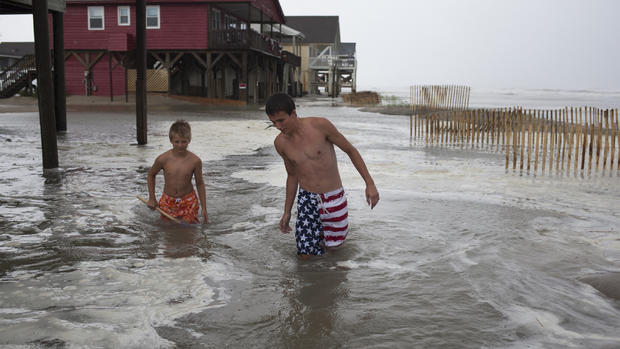Weakened Arthur moves into New England bringing downpours
A weakened Hurricane Arthur was swirling into southern New England Friday night and then on to Nova Scotia, bringing heavy rains but proving far less damaging than feared.
Parts of the Massachusetts coast saw particularly heavy downpours of up to 8 inches, CBS Boston reported.
Tropical storm warnings and watches were in effect for Cape Cod, Nova Scotia and New Brunswick in southeastern Canada.
The center of Arthur was to pass southeast of New England Friday night, and over Nova Scotia on Saturday and the Gulf of St. Lawrence on Saturday night, according to the National Weather Service.
"Arthur is expected to weaken on Saturday, but still remains a dangerous storm system for portions of eastern New England," the National Weather Service said. "The main threats with Arthur are high winds, heavy rain, dangerous surf and strong rip currents."
Earlier Arthur left tens of thousands of people without power Friday in a swipe at North Carolina's dangerously exposed Outer Banks, then brought lousy Fourth of July beach weather to the Northeast as it veered out to sea.
The weather along the narrow barrier islands - whose beaches draw scores of tourists every summer - was already clearing Friday as Arthur's outer bands scraped the Delaware and New Jersey shores.
Arthur struck North Carolina as a Category 2 storm with winds of 100 mph late Thursday, taking about five hours to move across the far eastern part of the state.
About 40,000 people lost power, and the rush of water from the ocean on one side and the sound on the other side buckled part of North Carolina Highway 12 in a spot on Hatteras Island that was breached in Hurricane Irene in 2011. Dozens of workers were heading to fix the highway, and the Department of Transportation said it was confident the road would reopen Saturday as long as an underwater sonar test of a key bridge showed no problems.
No injuries or deaths were reported. After praising emergency officials and saying the state dodged a bullet, Gov. McCrory noted that all of North Carolina's beaches were open outside of the Outer Banks and encouraged residents and visitors to enjoy the holiday. He was heading to the beach himself for an Independence Day parade in Southport, a welcome surprise when he expected to be stuck in Raleigh monitoring the storm all day.
"The North Carolina beaches are open for business and they're open for tourists," McCrory said. "The umbrellas are going up as we speak right now."
He warned of dangerous riptides though and urged beach-goers to heed the directives of local authorities.
"We do want people to enjoy the beach, but if the local authorities say, 'Don't get in the water,' don't get in the water and we mean it," he said.
While most of the damage was minor, in Nag's Head, restaurant owner Bryan Wilson raced to open in time for dinner after the Roanoke Sound rose four feet around his place.
"It should have been our best weekend," he said. "It's Fourth of July."
Seventy-six-year-old Virginia Colson spent Friday doing mop-up duty after a sleepless night.
"I sat here, up about 4 o'clock in the morning and watched shingles out my bedroom window flying off the roof," she said. "I'm even afraid to go see how much damage has been done there."
By Friday, Arthur had weakened to a Category 1 hurricane with maximum sustained winds around 90 mph, and additional weakening is expected, the U.S. National Hurricane Center said.
But the rain from Arthur's outer bands disrupted the holiday, with fireworks displays in New Jersey and Maine postponed until later in the weekend.
The first hurricane known to strike the U.S. on July 4, Arthur caused some frayed nerves on North Carolina's Outer Banks - a 200-mile string of narrow barrier islands with about 57,000 permanent residents and around 250,000 visitors on most summer weekends. A mandatory evacuation was issued for the southern Outer Banks. But while most visitors left, many residents stayed, accustomed to hurricanes that strike the area on average about every four or five years.
Jesse and Carol Wray rode out the storm in their home in Salvo on North Carolina Highway 12. They said the island was under several feet of water at the height of the storm. The six-foot-tall lamppost at the end of their driveway was under water except for its top, and that was after the sound a quarter-mile away receded several feet since first light, said Jesse Wray, a retired Norfolk, Virginia, firefighter.
"I'm surprised that it got this bad. There's all kind of debris floating around here. I know a lot of people who lost their houses around here" if they were built on the ground instead of elevated, said Wray, whose home is on pilings 9 feet high which kept it dry.
Arthur is the first named storm of the Atlantic hurricane season. It is the earliest in the season a hurricane has made landfall in North Carolina.

